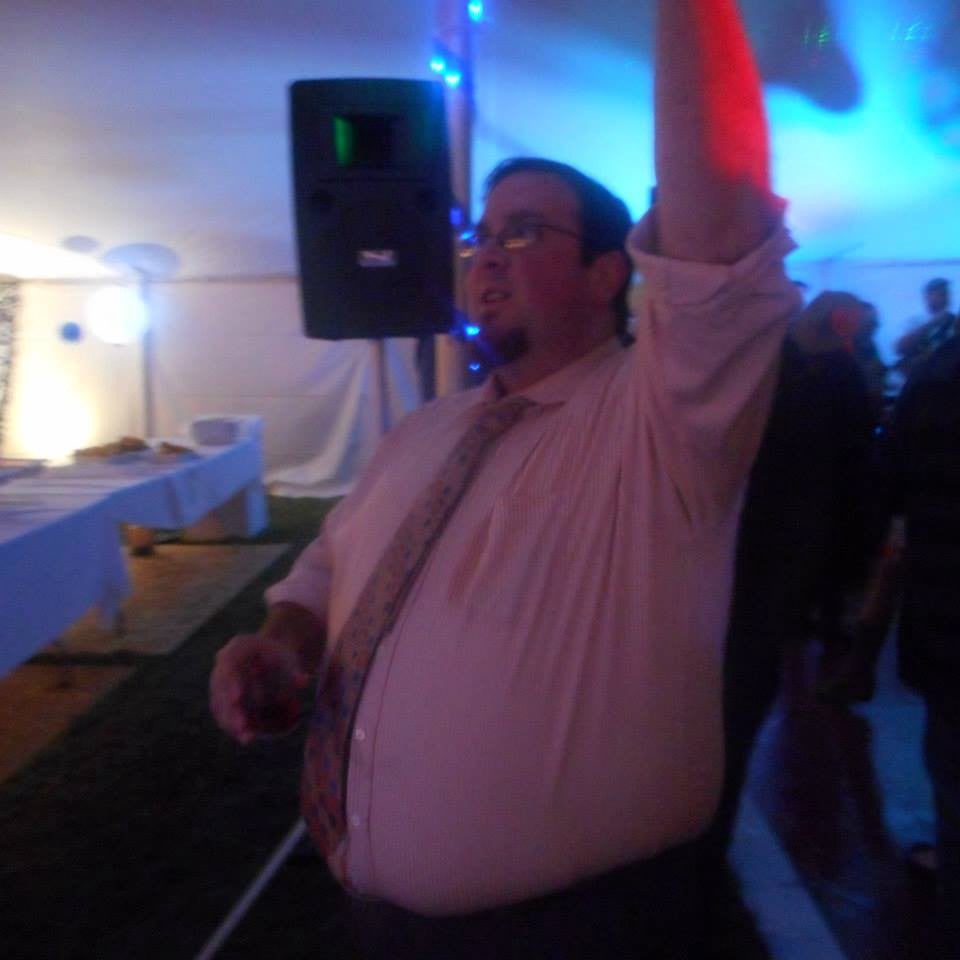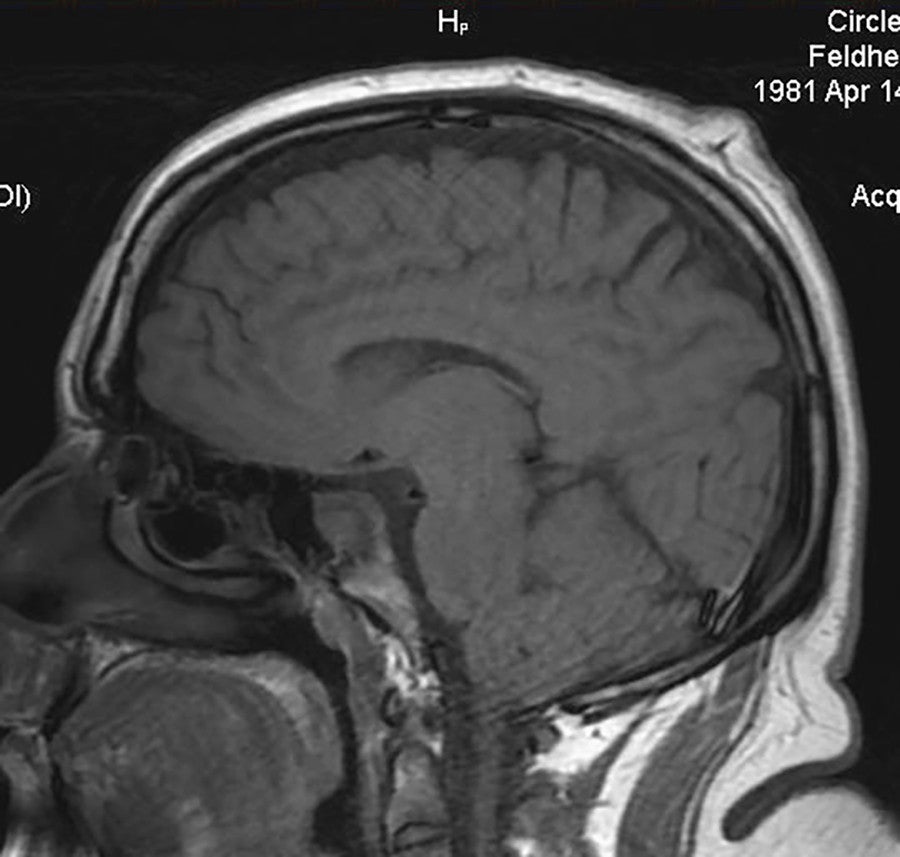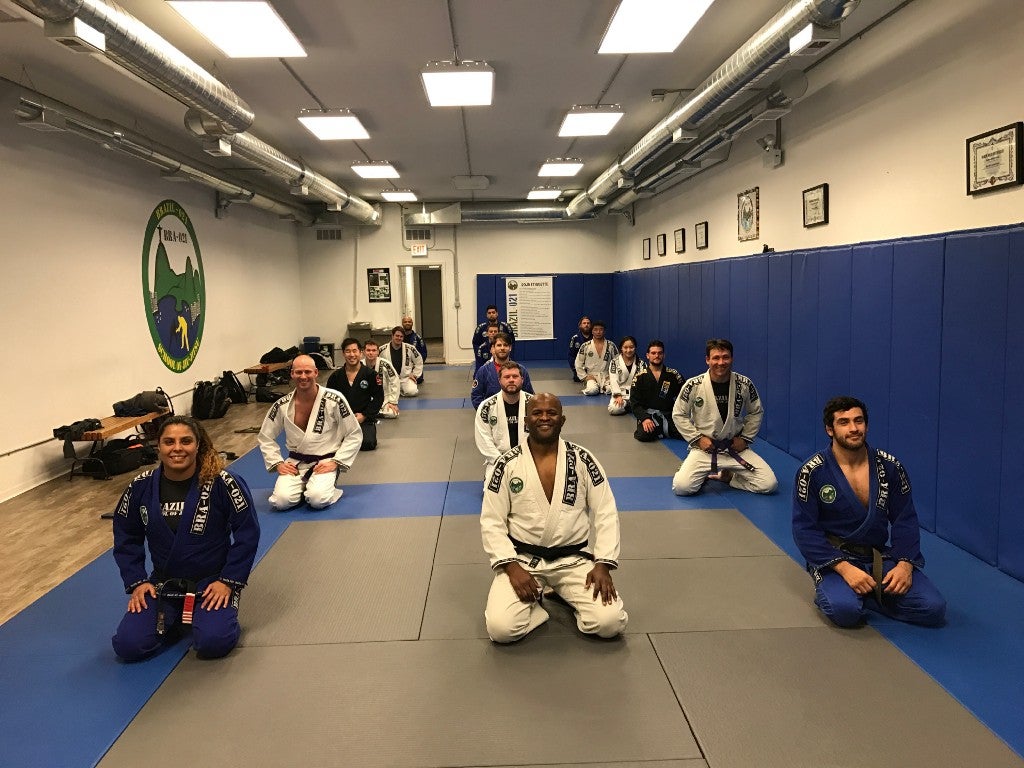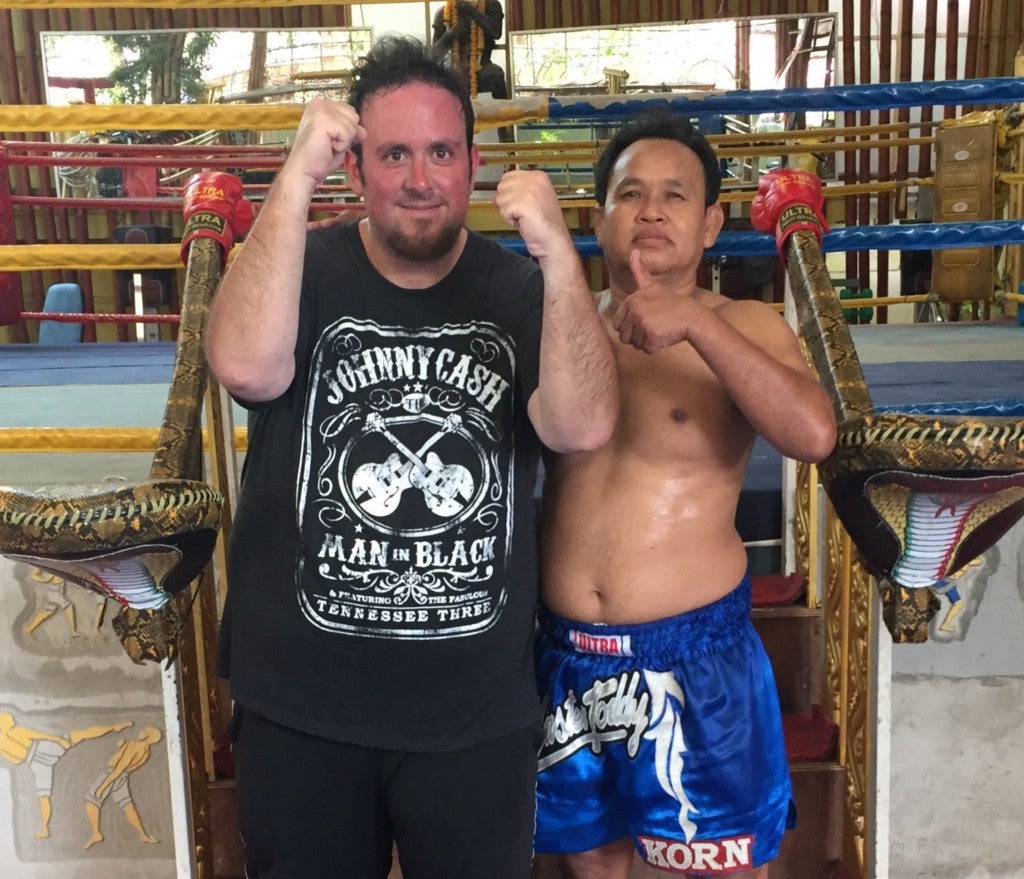The ring floor beneath my bare feet is warm. The man I only know as Korn smiles and holds the ring ropes open for me. I clumsily step through them onto the blue mat. There are no walls where Korn works—Master Toddy’s Muay Thai Academy—only a corrugated steel roof, which means nothing is stopping the 90-degree Bangkok heat from keeping me basted in sweat even when I’m standing still. Rows of red, yellow and black hanging bags flank the ring on one side; free weights, all-in-one pulley gyms and shelves of beat-up boxing gloves and training pads on the other.
Korn stands 5-foot-5-inches tall and possesses a toddler’s manic energy. He started fighting in muay thai matches at age 15. Now, he’s 53, his honed muscles still intact. I later reassure him when he complains about his slight middle-age paunch that my belly is much larger than his and I’m almost 20 years younger. Besides, he’s kicked a lot of ass in his lifetime. Out of 250 lifetime fights, he’s won 205 of them.
“Marching, marching…” he says, sharply emphasizing the -ar. He speaks little English, but the words he does know come out perfectly clear. He starts to shift his weight side to side, with his fists moving up and down near his face, opposite to his steps. Left hand up, right hand down with the right step. Right hand up left hand down, with the left step.
He squares up my stance and punches two quick left jabs and a right cross into the air. I do the same. I can do this, I think. I can do this.
Next, he straps oblong pads to his forearms, padded boots to his legs and a padded protector to his mid-section. “Left, left, right,” he tells me, motioning for me to punch his forearm pads.
I give a couple of light taps. Korn shakes his head and smacks his padded hands together hard, making a dull whipcrack sound. He points to his arm pads and then back to me. I punch a lot harder; a similar crack rattles through the gym. Now I do the combo again: Crack, crack, crack.
“Whoa! Better!” Korn exclaims. He starts embellishing, flying into the ropes as if I hit him really hard.
This was a big fucking deal for a guy like me.

Just a few months previously, I wouldn’t have been able to train with Korn. This despite the fact I’ve wanted to learn martial arts for most of the 35 years I’ve spent on Earth. But I didn’t, because I’ve sucked at sports for just as long. If a ball was involved, either I dropped it or I couldn’t run fast enough to catch it. Theater and band in high school? Gladly. Pizza and beer in college? Absolutely. Exercise after college? No way — it only brings shame and humiliation.
Not surprisingly, over the years that followed, I became a less able mammal. And by September 2015, I topped out at 315 pounds.
All of which, of course, begs the question: How the fuck did I end up at Master Toddy’s school? And how was I able to keep up with a guy whose professional fight record was 205–45? Well, for starters, I was paying Korn for beginner lessons — so it was his job to make me feel as though I was accomplishing something (and come back for more).
But more to the point, I was there for the same reason most out-of-shape people finally start working out: Shit got bad.
If that sounds familiar, it’s because it is. My weight-loss narrative is now the American weight-loss narrative — get fat, get sick (or sick of being fat) and get as fit as you can in order to save your life. You’ve certainly read about it. Or seen it on TV — whether involving celebrities or regular people who become quasi-celebrities. And if not, I bet you’ve seen your friends do it on Facebook. Whether it’s someone like me or Alvie Shepherd, a former first-round draft pick of the Baltimore Orioles I wrote about last year who shed more than 60 pounds by ditching his shitty eating habits because he had a brain aneurysm that should’ve killed him.
Like Shepherd, my brain had betrayed me, too.
Or, at least, it was fucked up enough that it scared me straight.

For most of my life, I’ve treated my body like a dumpster at a sports bar. If one hot wing was good, 15 doused in ranch was much better. I’ve dipped fries in blue-cheese dressing. I’ve eaten whole pizzas. When I first got my driver’s license, I drove to Burger King. It didn’t matter when I was a teen; I remained below 200 pounds the whole time.
But my “heaviest” number kept creeping up, slowly at first. I stayed below 220 throughout my 20s. A few months before turning 30, though, I tipped the scales at 245. I cleared out my savings and hired a personal trainer. Two months in, I was doing things I never did before: Running actual miles and stairs. Pushups. Burpees. Drinking protein powder. Recovery.

Two months in, I was down 18 pounds. But personal trainers are expensive. It also was late 2009, and both the country and I were in an economic turmoil, which meant I eventually had to cancel the sessions with my trainer. I kept the routine at the gym for the next month or so, but then I fell off. Next came the return of the junk food, followed by a new job with long hours and too many fast food chains nearby.
Three years later, I weighed 275 pounds — or about 30 more pounds than my previous high.
Not long after that, in May 2013, I started getting weird stabbing headaches. At best, they felt like an ice pick puncturing the right side of my skull. At worst, they felt like a drill boring into my brain. Advil and Aleve stopped working after about a year (though maybe they never worked in the first place). When the pills failed, I turned to the acupuncture table and an ever-growing list of home remedies. Ice packs. Caffeine. Chocolate with chilies inside for an alleged double shot of endorphins.
I did pretty much anything but go to the doctor. I just kind of hoped the problem would go away and that maybe it wasn’t as serious as it seemed; after all, the headaches would disappear for weeks at a time. Not that I wasn’t worried about them; quite the opposite. I was terrified of what was happening inside my head. I had dreams of dying in a hospital bed surrounded by tubes plugging a bunch of human-made orifices all over my body. During an acupuncture session, I saw my funeral, floating above the attended as they said their goodbyes.
Logic eventually prevailed, however — i.e., the headaches got worse — and I finally got an MRI in June 2015. It turned out I had a pituitary adenoma, a small growth that appears on the gland for no clear reason. People can live with them their whole lives and never know it. But I met mine and named it Biff. Why? Because have you ever met a Biff you liked? Me neither. Fuck Biff. He was 1.8 centimeters around and sitting on my pituitary gland, which was throwing my hormone levels out-of-whack and giving me all those nasty headaches. He also was likely clamping the brakes on my already-slow metabolism.

But here’s the good news — and where I got really, really, really lucky: Biff was small. He wasn’t spreading or touching bones or nerves. Treatment only involved pills that would regulate my hormone levels and shrink the fucker — no radiation, no chemo, no surgery. Immediately I went on them, my headaches stopped and my hormone levels started to normalize.
I also finally had my wake-up call to get in shape.
Well, almost.

With my new headache-free existence, breakfast became quinoa and beans with eggs and greens, and lunch was stir fries and bean-and-veggie combos. In winter 2015, I started working out at an excellent small-group training gym in Chicago three days a week called 312 Athletic Club.
Two months after joining the gym, I dropped about 10 pounds, to 305. I was becoming stronger, too. I could now squat like crazy when before I could barely hold the position for more than a minute. Even better, my back pain and weird knee aches faded away. But then I plateaued. The reason why wasn’t a mystery. I kept ordering takeout after work, and my weekends were filled with hangovers and brunch. Also, my hormone levels were close to normal, but they still hadn’t fully corrected themselves. My excellent, no-bullshit endocrinologist pointedly told me that to get them there, I needed to get in better physical shape.

That was the actual wake-up call.
Why? Because it was finally my turn to step up. I couldn’t depend on medicine to take me the rest of the way. I had to fully deal with how I eat and exercise myself.
As a result, dinner quickly became piles of sautéed vegetables with whatever protein I had on hand. Usually cod, salmon, halibut or barramundi, but also duck breasts, Beast Burgers and sausages when I craved something more junky. I found vegetables I liked way more than salads. Sear up some asparagus, and we can party. Grill zucchini or eggplant, and I’ll bring the bourbon. My kimchi mushroom soup with homemade stock is Instagram-worthy. And my chili verde will fuck you up — even without skin on the chicken.
Around the same time, Brazil-021 School of Jiu Jitsu opened a location near my home in Chicago. A few of my friends, who were going through similar reappraisals of their lives, went there first and I followed. It immediately spoke to me. It’s chess with chokeholds — you have to escape holds and find ways through your opponent’s defense while they’re sitting atop your chest. Similarly, you have to move explosively to take a position or get a hold and sustain it. “[Brazilian Jiu Jitsu] appeals to a part of my brain that I never visited before,” Anthony Bourdain once remarked, perhaps the truest words he’s ever spoken (at least to me).
The BJJ training made me just brave enough to try muay thai, which led me to Korn and Master Toddy’s Muay Thai Academy. I’d been in Thailand for a week — a gift to myself for vanquishing Biff — and had already grown bored of sightseeing. So instead, I let Korn put me through the paces for two sweltering hours, my first time practicing any kind of boxing.
Over the course of those 120 minutes, I did hundreds of knee hits into a heavy bag, raising my legs far higher than I’ve ever been able to at any other point during the last 3.5 decades. I punched combos of jabs, crosses, uppercuts and elbow hits. I mixed knee-to-head strikes with kicks. I sidestepped. I blocked. I marched. Nothing was out of reach.
Korn probably let me rest too much, but that was okay. He rubbed my arms, back and shoulders between drills as if I was in a real fight, even though I was wobbly and drenched in sweat. All the while, he kept encouraging me with a smile and a loud, “Goooooood!”
When it was all over, he brought me a bottle of cold water. It tasted so much better than all the burgers, pizza and wings that had led me here.
Not that I’ve given up any of those things completely. I still drink bourbon and beer. I still dip things in ranch and blue-cheese dressing. I still gorged myself too much during Thanksgiving, Christmas, Hannukah (for me anyway) and New Year’s. At the moment, I’m at about 280 pounds (or about 35 pounds less than my heaviest weight). So I haven’t lost 100 pounds in six months. But that’s not my goal anyway.

Too many times before, I’ve said, “I’ll never eat pizza or [insert awesome food here] ever again.” Only to have it never take. Now I’m saying, “I won’t eat pizza every day. Vegetables taste good, too. Exercise isn’t horrible.”
If I’ve learned anything, it’s that I don’t have to follow one key aspect of the American weight-loss narrative: It doesn’t have to happen overnight. In fact, it can and should take years. And that’s okay. Maybe by then what I’m doing now — eating mostly healthy and exercising regularly — will be such a part of my life that it’s no longer a thing; it’s just how I live.
“Health is not a number on the scale, but an overall picture of life,” Danny Cahill, the man who lost the second most amount of weight in Biggest Loser history only to find that keeping off the weight was just as much of a challenge, recently told me.
By that measure, I’m already in great shape.
